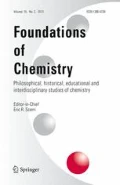Abstract
The paper is aimed at the issues of oxidation state determination and limiting values. The possibility of existence of compounds containing an atom with the oxidation number beyond the current common values, i.e., below −IV and above +VIII are discussed. Three principal modes of preparation of compounds with the oxidation number exceeding VIII, electrochemical anodic oxidation, photoionization, and nuclear β-decay, are evaluated. Failure to prepare compounds containing an atom with the oxidation number below −IV is rationalized. The paper provides an opinion on uncertainties in oxidation state determination in three kinds of compounds: binary compounds, nitrosyl complexes, and compounds containing mutually bonded atoms of the same element. The questions are discussed from the viewpoint of correlation of “man-made” quantities and objective, experimentally obtainable data.
Similar content being viewed by others
References
Andersson, K., Nyberg, M., Ogasawara, H., Nordlund, D., Kendelewicz, T., Doyle, C.S., Brown, G.E., Pettersson, L.G.M., Nilsson, A.: Experimental and theoretical characterization of the structure of defects at pyrite FeS2(100) surface. Phys. Rev. B 70, 195404 (2004)
Atkins, P.W., Jones, L.: Chemical Principles, The Quest for Insight, 3rd edn, p. 41. W.H. Freeman and Company, New York (2005)
Bartlett, N.: Xenon Hexafluoroplatinate(V), Xe+[PtF6]−. Proc. Chem. Soc. 218 (1962)
Berman, M., Beard, G.B.: Coulomb fragmentation of molecules following beta emission. Phys. Rev. Lett. 22, 753–755 (1969)
Chusuei, Ch.C., Goodman, W.: X-Ray photoelectron spectroscopy, pp 921–938, in encyclopedia of physical science and technology, analytical chemistry, vol. 3. AP, San Diego (2001)
de Puy, C.H., Garyev, R., Hankin, J., Davico, G.E.: Formation of BH6 + in the gas phase. J. Am. Chem. Soc. 119, 427–428 (1997)
Dementev, A.I., Kuznetsov, M.L., Kiselev, Y.M.: On the extremal oxidation states of heavy 5d elements. Russ. J. Inorg. Chem. 42, 1052–1057 (1997)
Ghosh, P.K.: Introduction to Photoelectron Spectroscopy, p. 170. Wiley, New York (1983)
Grapperhaus, C.A., Mienert, B., Bill, E., Weyhermüller, T., Wieghardt, K.: Mononuclear (nitrido)iron(V) and (oxo)iron(IV) complexes via photolysis of [(cyclam-acetato)FeIII(N3)]+ and ozonolysis of [(cyclam-acetato)FeIII(O3SCF3)]+ in water/acetone mixtures. Inorg. Chem. 39, 5306–5317 (2000)
Hollas, J.M.: Modern Spectroscopy, 4th edn, p. 320. Wiley, New York (2004)
Jörgensen, C.K.: Differences between the four halide ligands, and discussion remarks on trigonal-bipyramidal complexes, on oxidation states, and on diagonal elements of one-electron energy. Coord. Chem. Rev. 1, 164–178 (1966)
Kalemos, A., Mavridis, A.: Electronic structure and bonding of ozone. J. Chem. Phys. 129, 054312 (2008)
Kiselev, Y.M., Tretiakov, Y.D.: The problem of oxidation state stabilisation and some regularities of a Periodic system of the elements. Russ. Chem. Rev. 68, 365–379 (1999)
Kiselev, Y.M., Kopelev, M.S., Spicyn, V.I., Martynenko, L.I.: Octavalent iron, Dokl. Akad. Nauk SSSR 292, 621–628 (1987)
Lyubimova, O., Sizova, O.V., Loschen, C., Frenking, G.: The nature of the metal-nitric oxide bond in the [M(CN)5(NO)]q (M = Cr, Mn, Fe, Ru, Os, and Co) and trans-[Ru(NH3)4L(NO)]q (L = pyrazine, pyridine, N2, H2O, Cl−, CN−, NO2 −) complexes: A bond-energy decomposition analysis. J. Mol. Str. (Theochem) 865, 28–35 (2008)
Marcus, R.: Perspective on the M in RRKM theory. Spectrum 16(3), 4–21 (2003)
Nashikida, S., Ikeda, S.: Chemical shift of sulphur KLL auger electron energies in its compounds. Bull. Chem. Soc. Japan 51, 1996–2001 (1978)
Nefedov, V.I., Sinizyn, N.M., Salyn, J.V., Bayer, L.: Determination of charge of nitrosogroup in complexes by X-ray electronic methods. Russ. Coord. Chem. 1, 1618–1624 (1975)
Nesmejanov, A.N.: Radiochimija, p. 191. Chimija, Moskva (1972)
Pakiari, A.H., Nazari, F.: New suggestion for electronic structure of the ground state of ozone. J. Mol. Struct. (Theochem) 640, 109–115 (2003)
Pauling, L.: The Nature of the Chemical Bond and the Structure of Molecules and Crystals. An Introduction to Modern Structural Chemistry. Cornell University Press, New York (1947)
Pettersson, L., Bäckström, M., Brammer, R., Wassdahl, N., Rubensson, J.-E., Nordgren, J.: Nitrogen and oxygen K emission spectra of nitrous oxide. J. Phys. 17B, L279–L282 (1984)
Rother, P., Wagner, F., Zahn, U.: Chemical consequences of the 193Os(β−)193Ir decay in osmium compounds studied by the Mossbauer method. Radiochim. Acta 11, 203–210 (1969)
Sahrani, F.K., Aziz, M.A., Ibrahim, Z., Yahya, A.: Surface analysis of marine sulphate-reducing bacteria exopolymers on steel during biocorrosion using X-ray photoelectron spectroscopy. Sains Malaysiana 37, 131–135 (2008)
Seel, M., Kunz, B.A.: Band structure and electronic properties of lithium azide (LiN3). Int. J. Quantum Chem. 39, 149–157 (1991)
Šima, J.: Photochemical reactions of Iron(III) complexes: classification, mechanisms, and application. In: Sanchez, A., Guttierez, S.J. (eds.) Photochemistry Research Progress, pp. 103–160. Nova Science, New York (2008)
Su, G.L., Ning, C.G., Deng, J.K., Ren, X.G., Zhang, S.F., Huang, Y.R., Yang, T.C., Wang, F.: Direct observations of the chemical shift and electron momentum distributions of core shell in N2O. Chem. Phys. Lett. 422, 308–312 (2006)
Szacilowski, K., Macyk, W., Drzewiecka-Matuszek, A., Brindell, M., Stochel, G.: Bioinorganic photochemistry: frontiers and mechanisms. Chem. Rev. 105, 2647–2694 (2005)
Urch, D.S.: PAX (photoelectron and X-ray) spectroscopy and the electronic structure of moleculs, complexes, and solids. Arab. J. Sci. Eng. 13, 211–225 (1988)
Von Niessen, W., Kraemer, W.P., Diercksen, G.H.F.: Large scale ab initio calculations and the assignment of the photoelectron spectrum. Chem. Phys. Lett. 63, 65–68 (1979)
Waskowska, A., Gerward, L., Olsen, J.S., Steenstrup, S., Talik, E.: CuMn2O4: properties and the high-pressure induced Jahn-Teller phase transition. J. Phys. Condens. Matter 13, 2549–2562 (2001)
Xenides, D., Maroulis, G.: How does protonation affect the electron density of ozone? Mol. Phys. 100, 1057–1059 (2002)
Acknowledgment
This work was supported by the VEGA grant No. 1/0353/08.
Author information
Authors and Affiliations
Corresponding author
Rights and permissions
About this article
Cite this article
Šima, J. Oxidation number: issues of its determination and range. Found Chem 11, 135–143 (2009). https://doi.org/10.1007/s10698-009-9071-z
Received:
Accepted:
Published:
Issue Date:
DOI: https://doi.org/10.1007/s10698-009-9071-z




